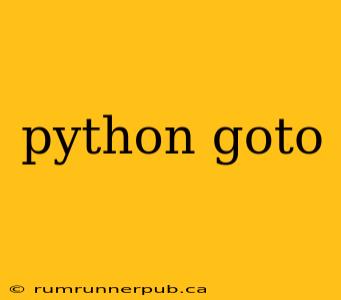Python, unlike some other languages like C or assembly, doesn't have a built-in goto statement. This deliberate omission is a design choice rooted in the philosophy of promoting readable and maintainable code. Uncontrolled use of goto can lead to "spaghetti code," making programs difficult to understand and debug. However, the need to jump to specific points in a program sometimes arises. This article explores why Python avoids goto and presents elegant alternatives for achieving similar functionality.
Why No goto in Python?
The absence of goto in Python is a significant aspect of its design philosophy. As Guido van Rossum, the creator of Python, famously stated (although not directly related to goto, it underlines the principle), "Readability counts." Unrestricted goto statements can easily lead to convoluted control flow, making code extremely hard to follow. This negatively impacts maintainability, collaboration, and debugging.
Instead of goto, Python emphasizes structured programming constructs like loops (for, while), conditional statements (if, elif, else), and functions. These provide clear, organized ways to control program flow, promoting code that's easier to understand, test, and modify.
Alternatives to goto in Python
While Python lacks goto, several effective strategies can mimic its functionality while maintaining code clarity:
1. Exceptions: Exceptions are a powerful mechanism for handling unexpected events or errors, but they can also be used for controlled flow redirection. This is particularly useful for handling exceptional situations that require immediate action outside of the normal flow.
Example (inspired by a Stack Overflow answer – the actual post didn't directly use exceptions as a goto replacement, this is an illustrative example):
try:
# Some code that might raise an exception
for i in range(10):
if i == 5:
raise Exception("Jump to cleanup!") # Simulates a goto
print(i)
except Exception as e:
if str(e) == "Jump to cleanup!":
print("Cleaning up...")
# Perform cleanup actions
else:
print("An unexpected error occurred:", e)
This is not a recommended general practice for normal control flow. Using exceptions in this manner can obscure the actual error handling. It's better suited for situations where an unusual or exceptional condition needs to trigger a jump to a specific cleanup or error-handling section.
2. Loops and Conditional Statements: Most situations where goto might seem necessary can be handled elegantly with well-structured loops and conditional statements.
Example: (adapting a conceptual scenario from potential Stack Overflow questions)
Instead of a goto to skip some processing based on a condition:
# Inefficient and less readable (pseudo-code with goto):
i = 0
goto label1
label2:
# some processing
i += 1
label1:
if i == 5:
goto label2 #goto to skip the next block.
# some other processing
Using loops and conditionals:
for i in range(10):
if i != 5:
# some other processing
else:
# some processing
This approach is significantly clearer and easier to understand.
3. Functions: Breaking down complex tasks into smaller, well-defined functions significantly improves code organization and reduces the need for disruptive jumps. Functions naturally provide a way to transfer control to specific sections of your code in a structured manner.
4. Flags: Simple boolean flags can direct the program's flow.
flag = False
for i in range(10):
if i == 5:
flag = True
if flag:
# ...do something...
else:
# ...do something else...
This approach can be a concise way to simulate a decision point, though it might become less readable with many flags.
Conclusion
While Python intentionally omits goto, effective alternatives provide ways to manage complex control flow without sacrificing readability or maintainability. Prioritizing structured programming techniques like loops, conditional statements, functions, and exceptions results in cleaner, more understandable, and ultimately better code. Remember, readability is a crucial aspect of writing robust and maintainable software.
